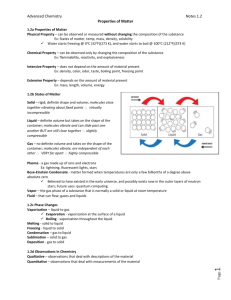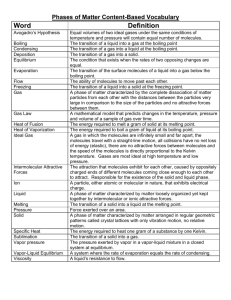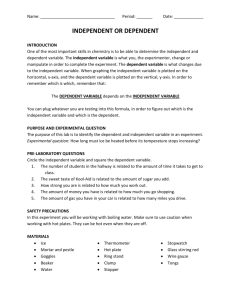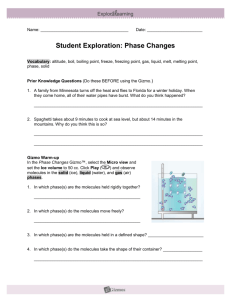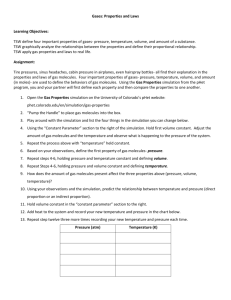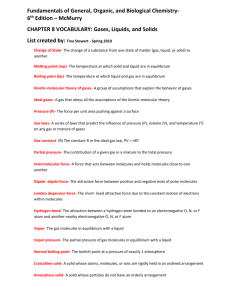Elevation (m)
advertisement
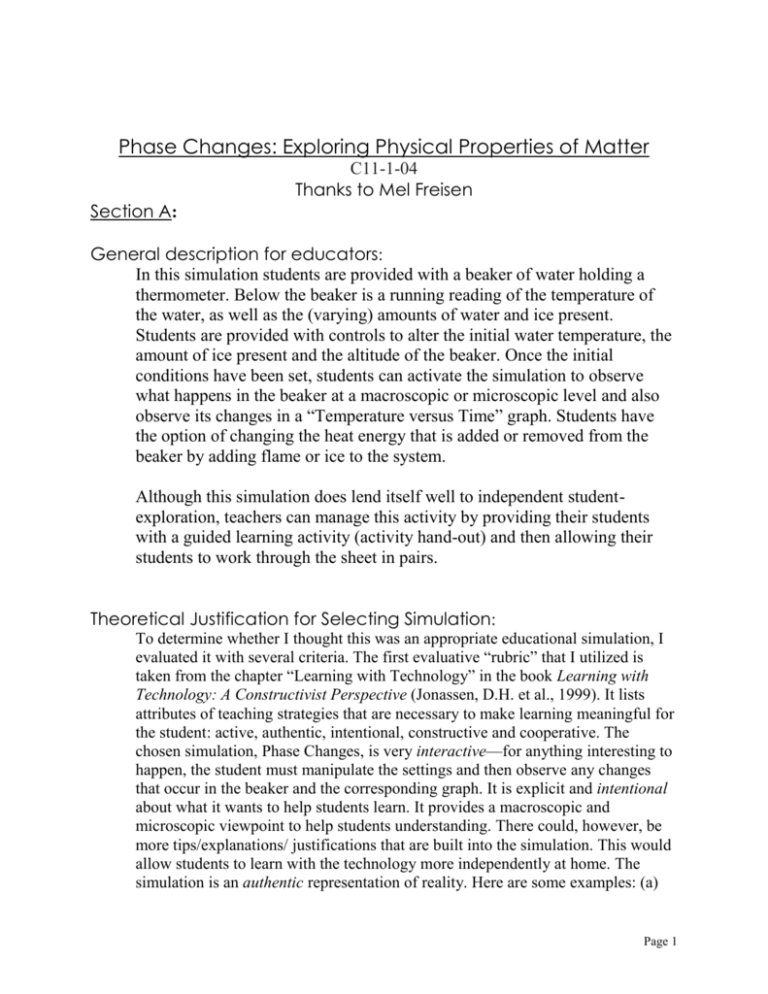
Phase Changes: Exploring Physical Properties of Matter Section A: C11-1-04 Thanks to Mel Freisen General description for educators: In this simulation students are provided with a beaker of water holding a thermometer. Below the beaker is a running reading of the temperature of the water, as well as the (varying) amounts of water and ice present. Students are provided with controls to alter the initial water temperature, the amount of ice present and the altitude of the beaker. Once the initial conditions have been set, students can activate the simulation to observe what happens in the beaker at a macroscopic or microscopic level and also observe its changes in a “Temperature versus Time” graph. Students have the option of changing the heat energy that is added or removed from the beaker by adding flame or ice to the system. Although this simulation does lend itself well to independent studentexploration, teachers can manage this activity by providing their students with a guided learning activity (activity hand-out) and then allowing their students to work through the sheet in pairs. Theoretical Justification for Selecting Simulation: To determine whether I thought this was an appropriate educational simulation, I evaluated it with several criteria. The first evaluative “rubric” that I utilized is taken from the chapter “Learning with Technology” in the book Learning with Technology: A Constructivist Perspective (Jonassen, D.H. et al., 1999). It lists attributes of teaching strategies that are necessary to make learning meaningful for the student: active, authentic, intentional, constructive and cooperative. The chosen simulation, Phase Changes, is very interactive—for anything interesting to happen, the student must manipulate the settings and then observe any changes that occur in the beaker and the corresponding graph. It is explicit and intentional about what it wants to help students learn. It provides a macroscopic and microscopic viewpoint to help students understanding. There could, however, be more tips/explanations/ justifications that are built into the simulation. This would allow students to learn with the technology more independently at home. The simulation is an authentic representation of reality. Here are some examples: (a) Page 1 molecules are shown in all three phases; (b) molecular movement is reasonably authentic—solids shake back-and-forth, liquids move about randomly, gases move all over, coming in and out of the screen; (c) molecules move at different velocities, depending on their phase and the temperature of the system; (d) shows that boiling points change when the elevation is altered. The hands-on, active nature of this activity promotes teamwork and cooperation while working through a worksheet. Cooperation in thinking must be guided by the teacher by means of an activity sheet—without a process facilitated by the teacher, it is unlikely that the students would make predictions and then test their hypothesis. Lastly, this simulation activity can organized into step-by-step learning, which allows the students to articulate their thoughts and reflect on what they are learning. Knowledge is constructed by starting with basic observations of molecules in a specific phase and then building on that base by progressing to phase changes, changes in altitude, and finally quantitative graphical analysis. My second evaluation criteria are taken from Jerry Wellington’s article, “Practical work in science – Time for a re-appraisal.” According to Wellington, the role or practical work in science is to illustrate science through first-hand, evidential experiences; to motivate and stimulate students; to challenge and confront students’ pre-conceptions; and to develop students’ skills, to list a few. This simulation does not directly confront students’ pre-conceptions about phase changes—therefore it is up to the instructor to address them prior to the lesson. The simulation does, however, provide meaningful evidential experiences that allow students to investigate molecular properties of phase changes that would not have otherwise been possible. The simulation may act to stimulate some students, but more realistically, I think students need a little guidance to help them focus their thinking and motivate them to explore the program. While I think that this simulation is a valuable teaching tool when used properly, it nonetheless has some limitations. Limitations: Temperature does not increase past 100°C – could the thermometer show the temperature of the water vapour? While viewing the graph, the zoom doesn’t allow for a full view of the entire simulation, only smaller portions of it – doesn’t allow for students to develop a more comprehensive understanding of the process. The temperature of the ice cools to -100°C – should the reason for this number be explained on the simulation? Curriculum Application: - Grade 11 Chemistry – Topic 1: Physical Properties of Matter Page 2 Curriculum Objectives: C11-1-02 Use the Kinetic Molecular Theory to explain properties of gases. Include: random motion, intermolecular forces, elastic collisions, average kinetic energy, temperature C11-1-03 Explain the properties of liquids and solids using the Kinetic Molecular Theory. C11-1-04 Explain the process of melting, solidification, sublimation, and deposition in terms of the Kinetic Molecular Theory. Include: freezing point, exothermic, endothermic C11-1-05 Use the Kinetic Molecular Theory to explain the processes of evaporation and condensation. Include: intermolecular forces, random motion, volatility, dynamic Equilibrium C11-1-07 Operationally define normal boiling point temperature in terms of vapour pressure. References: ExploreLearning. Grade 9-12 Science: Chemistry: Physical Properties of Matter: Phase Changes. 2007. Accessed September 29, 2007. <http://www.explorelearning.com/index.cfm?method=cResource.dspView& ResourceID=557> Grade 11 Chemistry: A Foundation for Implementation. “Topic 1: Physical Properties of Matter.” Manitoba Education, Citizenship, and Youth. 2006. Accessed September 29, 2007. <http://www.edu.gov.mb.ca/k12/cur/science/found/gr11_chem/topic1.pdf> Jonassen, D.H., Peck, K.L., & Wilson, B.G. (1999). Learning with Technology: A Constructivist Perspective. “Learning with Technology.” Columbus: Merrill. Wellington, Jerry. ”Practical work in science: Time for a re-appraisal.” Page 3 Exploring the Phase Changes of Water Welcome Explorers of Chemistry! During this activity you will be expanding your knowledge about the phase changes of water. You’ll get to observe the different phases of water at the molecular level and see what happens to the molecules as they change into a different phase. You’ll also get to explore how elevation affects phase changes. This activity will serve as the review for your test next week. It covers many aspects of what you’ve learned so far in the unit. For some of the questions you will have to apply what you’ve learned previously to new situations that you haven’t seen before. While working in pairs, one person should be working the mouse at the computer while the other person is in charge of recording your answers of the sheet. Make sure that you switch part way through the activity. Read through the instructions carefully, answer the questions as well as you can and make sure you and your partner both understand the question before you move on. To get to the simulation, follow these instructions: 1) Go to the website: http://www.explorelearning.com 2) Click on: Grade 9-12: Chemistry 3) Click on: Physical Properties of Matter 4) Click on: Phase Changes (2nd simulation) 5) Click on: Launch Gizmo Curriculum Objectives: During this assignment, you will have the opportunity to: o Use the Kinetic Molecular Theory to explain properties of gases, liquids and solids. o Explain the processes of melting and evaporation using the Kinetic Molecular Theory. This will include intermolecular forces, random motion, collisions, freezing point and boiling point. o Observe normal boiling point temperature and observe changes in boiling point due to changes in elevation. Page 4 Procedure: If you see a screen like this on your computer, you are in the right place: The simulation’s default initial conditions are: Temperature: 0°C Volume of Water: 200 cc (cc = cubic centimeters or cm3 = mL) Volume of Ice: 0 cc Altitude: 0 metres Add/Remove Heat Energy: 0 J/s (Joules per second) Take the next five minutes to explore the simulation: change the settings, look at the “Macro View” and “Micro View,” add heat energy, look at the graph – begin familiarize yourself with what it can do and then you can continue working through the worksheet together with you partner. Part A: Investigating the Phases Reset all of your settings back to the default settings, by clicking the Reset button . Set the Water Temperature to 20°C. Select the “Micro View” option. This will allow you to see what’s happening at the microscopic or particulate level. Press Play and observe molecules moving in liquid and in air above the beaker. Describe the movement of the molecules in the water. _________________________________________________________________ _________________________________________________________________ Moving above the beaker are gas molecules that represent some atmospheric gases. The green molecules represent Nitrogen gas (N2), the blue molecules represent Oxygen gas (O2), and the red and blue molecules represent gaseous water (H2O). [You will learn more about gases and the atmosphere in the next unit!] Page 5 Compare the movement of the gas molecules with the movement of the liquid molecules. Make sure you include collisions, kinetic energy, and intermolecular attraction in your comparison. _________________________________________________________________ _________________________________________________________________ _________________________________________________________________ _________________________________________________________________ You will soon add some ice to the beaker. (Don’t do it yet!) Describe what you think the movement of the molecules will be like in the solid phase. _________________________________________________________________ _________________________________________________________________ _________________________________________________________________ _________________________________________________________________ Now set the Ice Volume to 30 cc. Click Play and observe the solid phase. (Make sure you’re still in the Micro View.) Were your predictions about the movement of the solid phase molecules correct? Explain why the molecules in the solid phase move less than the molecules in the gas phase. _________________________________________________________________ _________________________________________________________________ _________________________________________________________________ We’re going to spend some time focusing on the collisions of the molecules and how they’re affected by different temperatures. Page 6 Initially you set the water temperature at 15°C. Soon you will change it to 85°C. Predict how the collisions will differ at the higher temperature. Will the collisions be harder than before? Will they occur at a different frequency? Explain why you think so. _________________________________________________________________ _________________________________________________________________ _________________________________________________________________ Increase the temperature of the water to 85°C and click Play. Write down some observations to help you remember key points: _________________________________________________________________ _________________________________________________________________ Adding Heat Energy To slowly watch the changes in molecular motion, you can set the water temperature and then add heat energy. This is shown by a flame located beneath the beaker (like the Bunsen burners that you use in the lab.) Click the Reset button. Pick a low water temperature and then add 200 J/s of heat energy. Press Play. As the amount of energy added to the water increases, what happens to the velocity of the molecular motion? _____________________________________________ Removing Heat Energy An alternative to adding heat energy to the beaker is to remove heat—or add cold to the beaker. When you move the heat energy bar to the left, the values become negative—as though you are subtracting heat from the beaker. This is shown by the ice cubes that are added around the beaker. Page 7 Predict what will happen to the molecular motion. Be sure to refer to changes in collisions and velocity of molecules. _________________________________________________________________ _________________________________________________________________ _________________________________________________________________ Click the Reset button. Pick a high water temperature and then remove 200 J/s of heat energy. Click Play. How was your prediction? Do your observations of the molecules in the cooling water make sense when you compare them to what happened when you heated up the water? Briefly explain. _________________________________________________________________ _________________________________________________________________ _________________________________________________________________ Part B: Investigating Phase Changes We’re now going to be adding enough heat or removing enough heat to cause changes in phase. Take a few minutes to talk with your partner about phase changes: What is occurring at the molecular level? What happens to the intermolecular attractive forces? Does the kinetic energy of the molecules change? How is the temperature affected? During this part you will get watch a “molecular journey” as solid phase molecules become liquid and then later become gaseous. We’re going to break down the journey into steps. Step 1: Solid to Liquid Click Reset and change the Ice Volume to 40 cc. (Make sure that the water temperature is 0°C and the Altitude is 0 metres.) Add 150 J/s of heat energy and Click Play. Watch as the ice cube is melting. You can observe how the water temperature and the volumes of water and ice are changing in the display below the beaker. Click Pause when it is about halfway melted. Page 8 What do you observe about the temperature of the water? __________________________________________________________ Click Play. Let the simulation run until the ice is just about melted. Click Pause again and record the water temperature: : Click Play. Let the simulation run for about another minute. Record the water temperature: What can you conclude about temperature changes during a change in phase? (How does the ice cube affect the rate at which water heats up?) _______________________________________________________________ _______________________________________________________________ If the heat energy you added (150 Joules per second!) didn’t cause any increase in the water temperature while the ice was melting, what happened to all that energy? _______________________________________________________________ _______________________________________________________________ _______________________________________________________________ Step 2: Liquid to Gas Click Play. Watch the simulation as the water continues to heat up. As the water temperature nears 100°C, you will see bubbles rising from the bottom of the beaker. What is in the bubbles? What is the name for the phase change as liquid turns into gas? _________________ Remember, since the altitude is 0 m or at sea level, the boiling temperature is called the normal boiling point. Page 9 Describe what happens to the liquid molecules as they are heated enough to become gaseous. Try to use the concepts of energy, attractive forces, and speed of molecules in your answer. ____________________________________________________________ ____________________________________________________________ ____________________________________________________________ What is happening to the volume of water is it is boiling? ______________ Where is the water going?________________________________________ As the water continues to boil, does water temperature change? Why or why not? (Hint: Look back to your answer about the temperature of water as the ice melts.) ____________________________________________________________ ____________________________________________________________ ____________________________________________________________ Predict what you think will happen to the temperature if you increase the heat energy added to 300 J/s: _____________________________________ Now test out your prediction. Increase the heat energy to 300 J/s. What do you observe about the temperature? _______________________________ ____________________________________________________________ Part 3: Using the Graph Select the Graph tab (next to the Controls tab). This view shows a “Temperature-Time” graph for the simulation you just watched. Move the graph screen back to the start of the simulation by selecting the zoom tool on the right of the graph. Locate the section of the graph that represents when the liquid was boiling. Page 10 Now locate the portion on the graph that represents where the ice was melting. Explain why these to portions have the same slope. ______________________ _______________________________________________________________ Temperature (°C) Using what you have observed in the temperature-time graph of water going through phase changes due to the addition of heat, create a temperature-time graph for water as it is cooled. The initial temperature of the water should be 100°C. Use the axes below for your sketch. 0 Time (seconds) Now check it out! Go back to the Controls tab, set the water temperature to 100°C, and move the heat energy slider to 400 J/s. Click Play and return to the Graph tab. (Or else, watch the Micro-View and then switch back to view the graph once ice is formed.) How did the velocity of the water molecules change as the temperature decreased? ______________________________________________________ Page 11 Part C: Boiling Point & Altitude As you learned in class last week, a liquid boils when its vapour pressure is greater than the pressure of the air (atmospheric pressure) pressing down on it. When a liquid boils at sea level (0 m elevation), the temperature at which it boils is called its normal boiling point. Click Reset. Set the altitude to 1,000 m, the water temperature to 60°C, and add 400 J/s of heat energy. Click Play and let the water boil. Boiling point? The boiling point at higher elevations is lower than the normal boiling point of 100°C. Thinking about the atmospheric pressure (the “weight” of the air pressing down on the water), explain why. _________________________________________________________________ _________________________________________________________________ _________________________________________________________________ Continue with your investigation of altitude and boiling point by filling out the second column—Boiling Point—in the table below and then graphing your results. Plot the data points as follows: Boiling Point: x-values; Altitude: y-values. For example, the first point is (0,100). Boiling Temperature (°C) Altitude (m) Boiling Point (°C) Freezing Point (°C) 0 100 1,000 2,000 4,000 6,000 8,000 10,000 0 Altitude (m) Page 12 Continue exploring phase changes by observing how increasing the elevation affects the freezing point of water. Click Reset. Set the water temperature to 10°C, keep the ice volume at 0 cc, and remove 300 J/s of heat energy. Click Play. As you learned from the exercises above, when water (or any other substance) goes through a phase change, the temperature does not change. So then, the freezing point of the water will be the point at which the water temperature (below the beaker) stays constant. Now fill in the last column—Freezing Point—in the above table. How is freezing point affected by elevation? Explain your observations. ___________________________________________________ _________________________________________________________________ _________________________________________________________________ _________________________________________________________________ Let the water keep freezing until there is no water left. What do you notice about the temperature of the water (actually, of the ice) once the freezing is complete? _________________________________________________________________ _________________________________________________________________ Page 13 Discussion Questions: We will discuss these questions as a whole class. If you finish earlier than other people, you can start reading over the questions and talk about them with your partner. Jot down as many notes as you need to to remember the information. 1.) Explain how the energy put into a system is used during a phase change. For example, when ice is melting, why does the temperature stay constant? ____________________________________________________________ ____________________________________________________________ ____________________________________________________________ 2.) Let’s look at phase changes in the opposite direction. Why does removing energy from boiling water (that is vaporizing) cause it to stop boiling? ____________________________________________________________ ____________________________________________________________ ____________________________________________________________ 3.) If you were cooking potatoes in the Himalayas, would the time needed to bring the water to a boil be less, the same, or more than it would here in Winnipeg? Why? ____________________________________________________________ ____________________________________________________________ ____________________________________________________________ 4.) What about the cooking time for the potatoes – would it be shorter, the same, or longer than in Winnipeg? ____________________________________________________________ ____________________________________________________________ ____________________________________________________________ Page 14 5.) A pressure cooker is a device that uses the relationship of pressure and temperature to cook foods at a faster rate than in a regular pot. If you know that pressure changes influence the boiling point, can you explain how pressure cookers work? ____________________________________________________________ ____________________________________________________________ ____________________________________________________________ 6.) Which of the following graphs represents water boiling in Banff, Alberta? (Elevation = 1463 m ) a. b. c. d. Graph A Graph B Graph C Graph D Page 15 7.) Can water boil below sea level? The European country of Holland (also known as The Netherlands) exists below sea level due to large dikes protected it from the ocean. How might this difference in elevation—below sea level—affect the boiling point of water? How would it affect cooking times? ____________________________________________________________ ____________________________________________________________ ____________________________________________________________ If you want to be quizzed a little more on these topics, try the Assessment Questions below the simulation! Page 16


